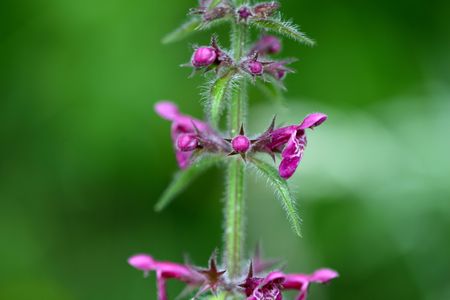Hedge Woundwort - Stachys sylvatica

Common Names: Hedge Woundwort, Woodland Betony, Hedge Nettle, All-heal, Whispot, Shady Hedge, Woundwort, Stachys sylvatica, Stachys, European Woundwort, Latin: Stachys sylvatica
Latin Name: Stachys sylvatica
Origin: Asia, Europe
Short Introduction
This plant is a favorite among bees. The best method for targeted cultivation is planting seeds, with the ideal sowing period being early spring during light frosts. Seeds should first be planted in individual pots, and once seedlings have grown (usually by summer), it is recommended to transplant them outdoors. Hedge Woundwort thrives in moderately shaded, cool sites, especially during its advanced summer growth. It grows in a variety of soil types but most prefers moist, wet, sandy-loam soils. The herb favors acidic soils but also grows in neutral or alkaline soils. Stems should be harvested just after flowering.
Detailed Description
An all-purpose herb, valued especially for stopping heavy bleeding and supporting wound healing.
Botanical Information
Hedge Woundwort is a perennial herb that can reach up to 120 cm in height. Its upright stem is simple, rarely branched, square-shaped, glandular, and densely hairy along its length. The leaves are arranged oppositely, heart- or egg-shaped, stalked, hairy, pointed at the tip, with regularly serrated and slightly toothed margins. The flowers, held on short stalks, have campanulate (bell-shaped) calyces and appear between June and September. The corolla is up to 2 cm long and dark purplish red. Typically, six flowers are arranged in false whorls. The fruit is a four-chambered nutlet.
Origin and Distribution
Hedge Woundwort is found throughout the temperate and subtropical regions of Europe, from Britain and southern Norway to Portugal, Sicily, and the southern reaches of Greece, extending east to the Caucasus, Siberia, Central Asia, and the Himalayas. It occurs almost all over Europe, with records of occurrences even north of the Arctic Circle. In the Czech Republic, it grows abundantly in lowland areas except in high mountain elevations or dry hills (in the Giant Mountains found up to 1200 m above sea level). Hedge Woundwort prefers clearings, edges of alluvial and deciduous forests, and is often found near water bodies.
Usage / Dosage
The herb's name relates to its traditional use in cleansing wounds and promoting healing. In the past, Hedge Woundwort was applied as poultices for cuts and various other injuries. Historically, the plant was believed to be an antidote to snake bites, as well as to ward off slander, curses, and gossip. In more recent times, alchemists of the modern era speculated that the herb contained gold in various forms, although we now know that when it comes to health, gold is not its greatest treasure.
The renowned 17th-century herbalist John Gerard was almost enchanted by this plant, describing its amazing healing properties in his writings. According to records, Gerard was once wounded by a scythe and a local farmer treated the injury with Hedge Woundwort. Subsequently, Gerard used the plant to care for very serious—sometimes life-threatening—injuries. Swiss herbalist Johann Kunzle described Hedge Woundwort as a herb that, like Foxglove, strengthens the heart but with fewer side effects.
The dried above-ground parts of Hedge Woundwort display antispasmodic properties and have long been cited in old magistral prescriptions for the treatment of cramping pain and joint pain. Thanks to its bioactive compounds, Hedge Woundwort demonstrates astringent and antiseptic properties, making it useful as a styptic (for stopping bleeding), for wound healing, and also in the treatment of diarrhea.
Traditionally, the plant was regarded as a universal remedy against a broad range of illnesses. The aerial parts of Hedge Woundwort confer benefits including antipyretic (reducing fever), antiseptic (against microbes), antibacterial (against bacteria), astringent (tissue tightening), antispasmodic (relieving cramps), carminative (reducing flatulence), diuretic (promoting urination), vermifuge (expelling worms), hypotensive (lowering blood pressure), tonic, and stomachic effects.
The herb's essential oil has antibacterial and natural antiseptic properties. Its tannins bind and neutralize foreign substances, detoxify, improve elimination of metabolic waste, and promote blood clotting by denaturing blood proteins. The compound stachydrin, which was extracted from the plant during wartime, can stop bleeding and helps heal wounds. Hedge Woundwort has been popular for treating both internal and external bleeding, for cramps, gout, and joint pain.
Traditional Medicine
In folk healing practices, the dried herb is used to stop bleeding by influencing blood coagulation. In gynecology, it was often administered to halt heavy bleeding. Folk healers gave Hedge Woundwort to tone the uterus, lower high blood pressure, and as a sedative. In European traditional medicine, the plant is recommended as a tonic, emmenagogue, diuretic, and general styptic. Folk remedies reference Hedge Woundwort for issues with the prostate and infections of the lower urinary tract.
Precautions
Due to a lack of safety information, Hedge Woundwort is not recommended for pregnant or breastfeeding women or children under 3 years of age.
Active Compounds
The aerial parts of Hedge Woundwort contain betaines (turicin, trigonelline, hyperoside, stachydrin, betonicin, betulinic acid), saponins, delphinidin, rutin, tannins (tannic acid), rosmarinic acid, ursolic acid, essential oil, vitamins, mucilaginous substances, alpha-pinene, beta-pinene, germacrene D, choline, allantoin, camphor, oleic acid, manganese, and other compounds.
Traditional Dosage
For various infections of the urinary tract, a decoction can be prepared by mixing 1–2 tablespoons of the herb with 250–300 ml of water or 1–3 teaspoons with 100–150 ml of water, simmered for 3–5 minutes, then left to infuse for 10–15 minutes, and consumed 3 times a day, 30 minutes before meals. A tincture can be made and used as needed at a dose of 15–25 drops, 2–4 times daily. Another recipe describes using 250 ml of water at 50°C and dissolving in 2–5 grams of the herb.
